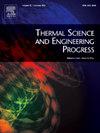Gas turbine heat rate prediction in combined cycle power plant using artificial neural network
IF 5.1
3区 工程技术
Q2 ENERGY & FUELS
引用次数: 0
Abstract
Artificial neural network (ANN) models for predicting the heat rate (HR) of gas turbines in a combined cycle power plant (CCPP) were developed and compared in this study. The heat rate, a critical performance indicator, reflects the amount of fuel energy required to electricity generation. A lower heat rate indicates higher efficiency and reduced fuel consumption. The first model uses seven input variables, including fuel gas temperature (FT), ambient temperature (AT), relative humidity (RH), compressor outlet temperature (CT), compressor outlet pressure (CP), variable guide vane (VGV), and gas turbine heat input (HI). The second model includes an additional input variable, power output (PO), making it an eight-input model. Both models were performed in MATLAB using the Levenberg-Marquardt algorithm, with node variations from 1 to 20, to determine the optimal network architecture. The 8-input model demonstrated superior performance, with a higher prediction accuracy (R2 = 0.986) and lower mean squared error (MSE = 518) compared to the 7-input model (MSE = 1,053). PO shows the strongest inverse relationship to HR (R = −0.898), which aligns with thermodynamic principles, where increased power output corresponds to improved energy conversion efficiency. CP, HI, and VGV also have significant negative relationships with HR. These findings indicate that incorporating power output as an additional input variable significantly improves the model’s ability to predict the heat rate. The ANN models offer a reliable and accurate tool for monitoring heat rates, optimizing energy efficiency, and supporting operational decision-making in gas turbines at combined-cycle power plants.
求助全文
约1分钟内获得全文
求助全文
来源期刊

Thermal Science and Engineering Progress
Chemical Engineering-Fluid Flow and Transfer Processes
CiteScore
7.20
自引率
10.40%
发文量
327
审稿时长
41 days
期刊介绍:
Thermal Science and Engineering Progress (TSEP) publishes original, high-quality research articles that span activities ranging from fundamental scientific research and discussion of the more controversial thermodynamic theories, to developments in thermal engineering that are in many instances examples of the way scientists and engineers are addressing the challenges facing a growing population – smart cities and global warming – maximising thermodynamic efficiencies and minimising all heat losses. It is intended that these will be of current relevance and interest to industry, academia and other practitioners. It is evident that many specialised journals in thermal and, to some extent, in fluid disciplines tend to focus on topics that can be classified as fundamental in nature, or are ‘applied’ and near-market. Thermal Science and Engineering Progress will bridge the gap between these two areas, allowing authors to make an easy choice, should they or a journal editor feel that their papers are ‘out of scope’ when considering other journals. The range of topics covered by Thermal Science and Engineering Progress addresses the rapid rate of development being made in thermal transfer processes as they affect traditional fields, and important growth in the topical research areas of aerospace, thermal biological and medical systems, electronics and nano-technologies, renewable energy systems, food production (including agriculture), and the need to minimise man-made thermal impacts on climate change. Review articles on appropriate topics for TSEP are encouraged, although until TSEP is fully established, these will be limited in number. Before submitting such articles, please contact one of the Editors, or a member of the Editorial Advisory Board with an outline of your proposal and your expertise in the area of your review.
 求助内容:
求助内容: 应助结果提醒方式:
应助结果提醒方式:


